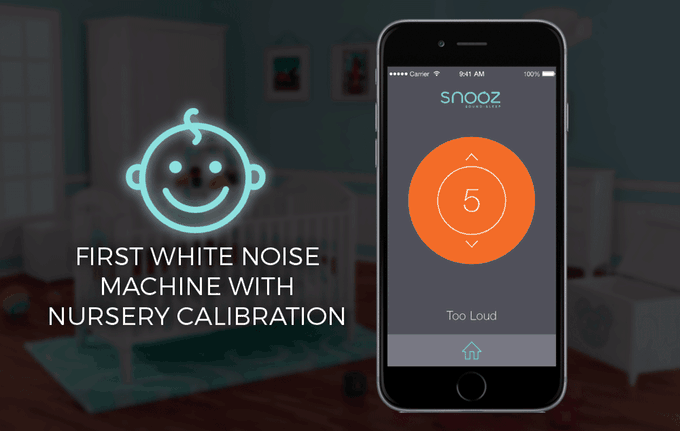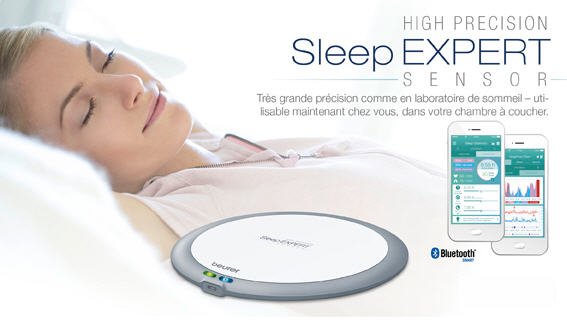Garmin Forerunner 935 vs 945: Garmin Forerunner 945 with mp3 player, contactless payment and color mapping is the top of the range for triathletes, pros and enthusiaststhe.
Best price Garmin Forerunner 935
Best price Garmin Forerunner 945
After the excellent high-end Forerunner 935 watch released in 2017, Garmin has been offering a new model since May 2019: the Forerunner 945. The Forerunner 935 was an almost exact copy of the best Garmin watch at the time (the Fenix 5) but in a lighter version and with greater autonomy. The Forerunner 945 incorporates all the characteristics of the Forerunner 935 but by adding the latest novelties of its high-end watches (those of the Fenix 5 Plus, Fenix 5X Plus and some new ones from the Garmin MARQ luxury series), a markedly autonomy larger and new functions not included, all for a price of $100 lower than the Fenix 5 Plus! (see less according to current promotions, see our offers above).
There are all the functions of the Forerunner 935 and, in addition, many functions including the color mapping and the cycle paths of Europe, a mp3 player, the contactless payment solution Garmin Pay, a pulse oximeter, a popular route generator, a round trip generator, a assistance in the event of an incident, more than metrics and tools for training some of which are very useful and easy to use even for a beginner athlete.
So there is something to ask the question: should you buy the Forerunner 935 whose price has dropped significantly? Or should you rather take the step and buy the Forerunner 945 which benefits from breathtaking functions? Or should we wait for a Fenix 6 to come soon?
In this article, you will find a detailed comparison of the 2 models, explanations to help you understand the new features of the Forerunner 945, and our opinion to help you make the right choice.
Price and physical characteristics compared
| Model | Forerunner 935 | Forerunner 945 |
|---|---|---|
| Price | € 449 | € 599 |
| Autonomy (GPS mode) | 24h | 36 h |
| Case size | 47 x 47 mm | 47 x 47 mm |
| Thickness | 13.9mm | 13.7mm |
| Screen size | 1.2 “(30.5mm) | 1.2 “(30.4 mm) |
| Glass material | Glass | DX Corning Gorilla Glass |
| Resolution | 240 x 240 px | 240 x 240 px |
| Touchscreen | No | No |
| Color display |
•
|
•
|
| Weight | 49g | 50g |
| Interchangeable strap | Yes, QuickFit ™ | Yes, QuickFit ™ |
| Waterproof | 5 ATM (50 m) | 5 ATM (50 m) |
| Memory | 64 MB | 16 GB |
Forerunner 935 versus 945: comparison of the main characteristics
The price: at least 150 € more: expensive and at the same time not expensive!
The price is often a decisive criterion in the choice of a cardio watch. That of the new high-end triathlon watch passes the psychological barrier of € 500 with a price of around € 600, against € 449 (and up to € 80 cheaper with current promotions) for the previous model! Something to think about before getting started!
At the same time, given the new features added by Garmin, here is a more complete watch than the Fenix 5 Plus. The € 150 or even € 200 difference can be explained. Then see if you want to pay as much for functions that you may not use. Hopefully Garmin will continue to offer the 2 models in parallel, it would make sense.
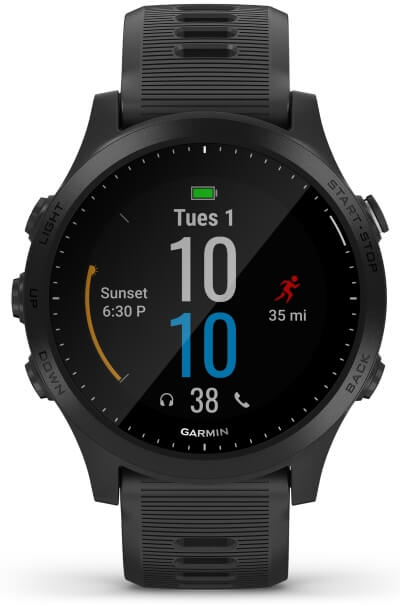
Design, structure and robustness
In terms of design, the 2 watches are almost identical, apart from the slightly darker color of the buttons on the Forerunner 945. Difficult to differentiate them. As for the weight, it only varies by one gram (49 g for the Forerunner 935 against 50 g for the Forerunner 945). Suffice to say that we do not feel the difference on the wrist.
In terms of robustness, the glass of the Forerunner 945 is more solid. Garmin has indeed adopted a Corning Gorilla glass, very resistant to shocks, instead of the classic glass of the old model.
There is also the system of interchangeable straps without QuikFit ™ tools, so the possibility of reusing the straps of the Forerunner 935. That’s a good thing.
The screen
More and more watches offer a touch screen, color and high resolution. This is explained by the multiplication of data displayed, the customization of watches with the display of wallpapers and the arrival of cartography. Garmin does not seem to take this point into account, however, and retains a non-touch screen and a resolution, albeit correct, of 240 x 240 px. Too bad the American company has not aligned with the competition. This would have been a plus for navigation from maps. Suunto and Amazfit indeed offer a touch screen of 320 x 300 px on the Vantage V and the Stratos and Samsung a touch screen also of 360 x 360 px on its Galaxy Watch.
Weight and thickness
Weight and thickness are important criteria for sports such as running or triathlon. A light and thin watch is less felt on the wrist than a bulky and heavy watch. With 50 g, the 2 watches are part of the “featherweight” and look great compared to the Fenix 5X plus whose weight reaches 96 g, almost double, metal case requires!
The thickness of the case decreases very slightly with 0.2 mm less for the new model.
Autonomy: + 50% (36 h) for the Forerunner 945!
Autonomy is today an important even decisive criterion in the choice of a cardio-GPS watch. It is even an eliminatory criterion for the followers of races of type “ultra” with durations of use which can largely exceed the 40 h. For shorter outings, autonomy also remains an essential criterion: what a frustration to run out of battery during an outing because you forgot to charge your watch the day before!
| Model | Forerunner 935 | Forerunner 945 |
|---|---|---|
| Watch mode | 2 weeks | 2 weeks |
| GPS mode | 24h | 36 h |
| UltraTrac mode | 60 h | 60 h |
| GPS mode with music | 10 a.m. | |
| Rechargeable during the activity |
•
|
•
|
Forerunner 935 versus 945: comparative autonomy
Record range for the new Forerunner 945
Garmin significantly improves the autonomy of its watch, going from 24 h to 36 h (or even 40 h in one of the brand’s descriptions) for GPS mode. We stay at 2 weeks of autonomy in watch mode and 60 h in ultraTrac mode without the use of cardio (50 h with use of cardio). The use of the mp3 player obviously leads to these figures with an autonomy which increases to 10 h max. The music player and the bluetooth transmission are indeed very greedy.
In comparison, the Fenix 5 Plus barely takes 18 h in GPS mode, the Suunto 9 Baro 25 h (but 120 h in ultra mode thanks to FusedTrack and unrivaled precision for an energy saving mode) and the Amazfit Stratos at 35 h. Also read our comparison of the best triathlon watches for a detailed review.
Garmin succeeded in this feat by adopting the Sony GPS chip, already used by Polar and Suunto, which consumes less energy than the previous Sirf chip.
The GPS chip is indeed one of the components that consumes the most energy in a cardio watch. To save battery and extend battery life, manufacturers sometimes offer an energy saving function (ultra mode) which consists of spacing out GPS readings. This decreases the accuracy of the measurements all the more. The manufacturers of GPS chips, for their part, are working to reduce the consumption of their chip, sometimes to the detriment of the accuracy of the measurements … That said, the Broadcom company announced in 2017 the release of a much more precise chip ( about 20-30 cm instead of 2 to 10 m currently) for a consumption 2 times lower. It already equips most of our smartphones and may soon be able to integrate cardio watches!
Charging without stopping the watch
Regarding the recharging of the watch, no change for the Forerunner 945: it is always done on the back of the case, by a cable which connects vertically to the watch. It is therefore impossible to recharge it without removing the watch from the wrist. Pity. You can however reload it without stopping the recording.
Sensors: an additional oximeter and Galileo compatibility
The 2 watches carry almost the same sensors (barometric altimeter, compass, gyroscope, accelerometer and thermometer). The difference is in the optical sensor and the GPS:
- New less energy-consuming GPS chip (Sony replaces Sirf)
- New optical heart rate sensor designed to work underwater
- Pulse oximeter and pulse OX function
| Model | Forerunner 935 | Forerunner 945 |
|---|---|---|
| Barometric altimeter |
•
|
•
|
| GPS systems | GPS, GLONASS | GPS, GLONASS, Galileo |
| Wrist cardio |
•
|
•
|
| Wrist cardio works underwater |
•
|
|
| Pulse oximeter |
•
|
|
| Compass |
•
|
•
|
| Power | With external sensor | With external sensor |
| Gyroscope |
•
|
•
|
| Accelerometer |
•
|
•
|
| Thermometer |
•
|
•
|
| Weather functions |
•
|
•
|
| Calendar |
•
|
•
|
| Compatibility of external sensors | ANT +, Bluetooth | ANT +, Bluetooth |
Forerunner 935 versus 945: the sensors compared
An additional pulse oximeter and measurement of heart rate underwater
The Forerunner 945 is equipped with a new optical heart rate sensor that will work underwater. You will just have to wait for a next software update for this.
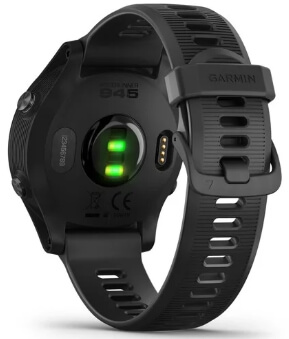
Garmin also added a pulse oximeter or saturometer to his watch. It is used to measure the oxygen saturation of the blood. The measurement is carried out by an additional LED added to the optical sensor. Garmin uses this value (pulse OX function) to assess the athlete’s acclimatization to altitude and heat and to assess the quality of sleep. These tools should allow even more detailed monitoring of performance.
This function had already been proposed on the Fenix 5X Plus but it was only used for very high altitude trips and aimed to prevent the risks of accidents related to lack of oxygen. The blood oxygen level should not drop below 95%. Learn more about this function and how the measurement is performed.
GPS: a new chip and access to the Galileo satellite network
As we specify above, Garmin opted for a new Sony GPS chip less energy-consuming but a priori less precise too. Garmin has also chosen to activate access to the Galileo satellite network. The Sony chip is indeed compatible with Galileo but not all manufacturers necessarily activate this function. This should allow for greater satellite coverage and quicker hanging, although in practice things are a bit more complicated.
A few years ago, GPS watches operated with only one satellite network, the American system (GPS). Today, other systems are accessible such as the Russian (GLONASS), Japanese (QZSS or Michibiki) or European (Galileo) satellite systems. Having more satellites improves the acquisition time but not necessarily the accuracy. Manufacturers offer chips compatible with several satellite systems, but watch manufacturers do not always exploit these possibilities. There are several reasons for this. The use of several systems adds to the consumption of the watch. On the other hand, the position reading is done with a single satellite network and not a mix of several networks, which means that the accuracy can be less good than with a single system (for example if the GLONASS is received in first by the watch where the GPS would have given better accuracy).
Compared features
In terms of functionality, it is above all the addition of mapping, an mp3 player, a contactless payment solution, an assistance function and a pulse oximeter which is the biggest evolution of this watch.
But that’s not all: Garmin adds new metrics and tools for monitoring the athlete. These additions are not just a few additional functions drowned out among the others but relevant, practical tools that should really help athletes of all levels to better monitoring their progress and optimize their training.
We summarize these new features just after the summary table below of the main features.
| Model | Forerunner 935 | Forerunner 945 |
|---|---|---|
| GPS navigation |
+
|
+++
|
| Nb of sports | 35+ | 35+ |
| Multisports (sequences) |
•
|
•
|
| Cartography |
•
|
|
| Cycle paths |
•
|
|
| Mp3 player |
•
|
|
| Contactless payment |
•
|
|
| Functions for golf |
•
|
•
|
| Preloaded golf courses | Yes, 41,000 | |
| Popular route generator |
•
|
|
| Round trip route generator |
•
|
|
| ClimbPro ™ function |
•
|
|
| Altitude profile |
•
|
•
|
| Future elevation profile |
•
|
|
| Download training |
•
|
•
|
| Split |
•
|
•
|
| Training tracking |
•
|
•
|
| Physiological measurements |
•
|
•
|
| – VO2max | Yes | Adjusted according to T ° and altitude |
| – Race predictor |
•
|
•
|
| – Training effect 2.0 |
•
|
•
|
| – Lactic threshold |
•
|
•
|
| – Recovery time |
•
|
•
|
| – Training load |
•
|
•
|
| – Training status |
•
|
•
|
| – Training load target |
•
|
|
| – Body battery |
•
|
|
| – Stress monitoring |
•
|
|
| – Breathing frequency |
•
|
|
| Race dynamics (ex: cadence, stride length …) | 6 | 6 |
| Stress Review |
•
|
•
|
| Physical condition |
•
|
•
|
| Virtual partner and racer |
•
|
•
|
| Strava (tag, dynamic segments) |
•
|
•
|
| Segments (Live, Garmin) |
•
|
•
|
| smart health connected functions |
•
|
•
|
| Activity monitoring |
++
|
+++
|
| Pulse oximeter |
•
|
|
| LiveTrack, Group LiveTrack |
•
|
•
|
| Event sharing in real time | No | Android only |
Forerunner 935 versus 945: compared features
The big changes: mapping, mp3 player, Garmin Pay, oximeter, assistance
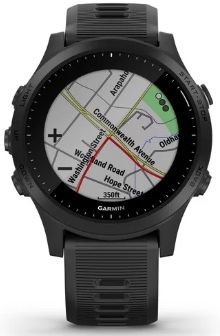
-
- Color mapping and cycle paths: the maps (roads and paths) and cycle paths of the country or continent of purchase (47 European countries for a purchase in France) are preloaded in the watch and can be viewed even offline. The GPS navigation functions are obviously adapted to use the maps (“around me” function, route generators, ClimbPro function).
- An mp3 player : a function already present on the latest Garmin watches and which is generalized to mid-range watches and above but which, in order not to increase the price of the watch too much, remains optional on certain models (Forerunner 245 and 645). About 1000 music titles can be loaded into the watch memory. You can also listen to music streaming on Deezer and Spotify and download playlists (paid subscription). This is a very useful function for running light without having to carry a Smartphone.
- Garmin Pay: it is the famous payment solution from Garmin which allows you to pay for small purchases thanks to the NFC chip found in smartphones and recent bank cards. This function must be activated beforehand from a PC or Smartphone. Once in place, a simple access code allows you to activate it on the watch. Payment is made without connectivity. The function is automatically deactivated when the watch is removed from the wrist.
- A round trip generator: thanks to the on-board maps, Garmin can offer routes according to a given direction and maximum distance. A very practical function when you go to play sports elsewhere than at health home, on vacation for example, or to explore new routes.
- A popular route generator: Garmin uses the billions of user data to provide the most frequently used routes and routes around the user’s location. This allows you to think outside the box and discover new routes. This function existed on the Edge 1030 bike GPS (and now Edge 530 and Edge 830). Garmin now offers it on its high-end Fenix 5 Plus and Forerunner 945 watches.
- Analysis of the altimetric profile of the route: a function that will delight experienced runners and cyclists who train in mountainous regions, but also hikers and skiers. It analyzes the altimetric profile of the course and informs the user about the ascents to come, the distance remaining to be covered to reach it, the difficulty and more. Once there, it indicates the average slope, the distance and the slope still to climb. We can thus manage our effort accordingly.
- The future altitude profile: this function calculates, from topographic maps, the altitude profile of the route. A practical function to assess the difficulty of the course and adjust its effort accordingly.
- A pulse oximeter and the pulse OX function: see our explanations above.
- 41,000 preloaded golf courses: For golf lovers, the Forerunner 945 now has an impressive number of golf courses around the world. On the Forerunner 935, you had to load the chosen route before you could start a game. In addition to the features already available for golf, Garmin adds automatic CourseView updates (zoom on the course).
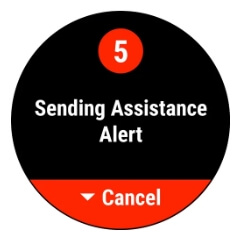
- Assistance in the event of an incident: watch manufacturers seem to be increasingly interested in the safety and health of their users. After the pulse oximeter at Garmin, functions dedicated to health (EKG, fall detection, SOS call) at Apple and its Watch 4, Garmin integrates into its Forerunner 945 an assistance function in the event of an incident (detection fall, assistance request with manual or automatic sending of the user’s name and GPS coordinates). A tool that should reassure athletes who go to do sport alone, in the mountains for example.
New tools and metrics for training and performance monitoring
The new Forerunner 945 brings several innovations that should appeal to all those who do not have the knowledge to exploit the many metrics offered by the watch. Garmin has apparently wanted to offer practical and easy-to-use tools to progress.
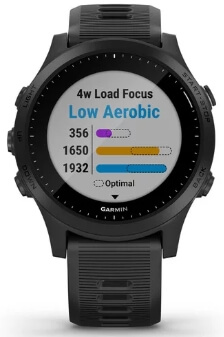
- The training load objective: a very interesting and easy to use function to progress. It complements the training load (indication by the watch of the volume of your training over the last 7 days. It is defined in 3 categories: high, optimal, low). This is a new widget (see our photo) which displays, in the form of bars, the level of effort provided according to 3 categories (low aerobic, high aerobic, anaerobic). The goal is to manage your training so that the 3 bars are filled. For example, if the “High aerobic” bar is filled but the “Low aerobic” bar is empty, it will be necessary to train more in fundamental endurance than in interval training or in intensity for example.
- The Body Battery function: it estimates your energy reserve. This increases when you relax or when you sleep, all the more if the sleep is restful. It decreases when you exert yourself, exercise or even under stress. The watch gives an idea of your reserves and allows you to make the right decisions: is it a good idea for example to go to train after work when my reserves are empty?
- The main benefit: Garmin does not specify what this function is for, which he also calls training effect labels or markers. It could be the storage of the best recorded metrics. For example the best VO2max value recorded since the start of training or the best state of form.
- monitoring the menstrual cycle: this feature that will appeal to women is not exclusive to the Forerunner 945. It has been integrated into Garmin Connect with the release of the latest Forerunner. It aims to help women make the link between their current cycle phase, physical and emotional state, pain, and general well-being.
- Measuring the respiration rate: this function requires a chest belt to measure the number of breaths per minute (evaluation by the Firstbeat algorithm from the variability of the heart rate). It will assess progress by comparing the number of breaths for 2 identical exits or of similar difficulty.
- VO2max adjusted as a function of altitude and heat: VO2max is a very useful performance indicator for assessing performance and progress. Garmin improves its measurement by now taking into account heat and altitude. The idea is to add greater precision to this value to avoid surprises when, for example, you train at low altitude for a competition planned at altitude.
- Measuring the level of stress throughout the day: this function constantly assesses your stress level and can alert you and help you relax by practicing breathing exercises. The measurement is used by the Body Battery function (the higher the stress, the more the “batteries” in the body are used up).
- Activity monitoring: the watch measures your daily activity and your sleep if you wear it 24 hours a day. It informs you of your activity (number of steps, distance traveled, calories expended, climbed floors, etc.) and encourages you to move. Garmin adds 2 new functions: the measurement of stress throughout the day and the Body Battery function described above.
Our opinion: Garmin Forerunner 935 or 945? Which one to choose ?
Between the 2 watches, there is no picture since the Forerunner 945 takes all the characteristics of the Forerunner 935 and adds new functions which undoubtedly make it the most complete watch on the market to date. The increased autonomy also makes it more viable for long runs (ultra-deep, ultra-trail, etc.). The choice between the 2 watches should therefore rather be made in relation to your budget.
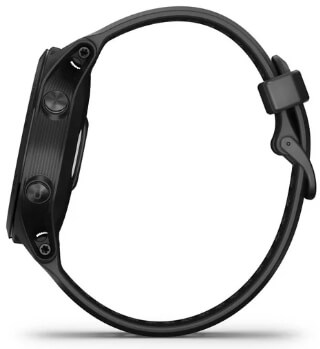
It is true that the Forerunner 945 is clearly a choice that we recommend. It is ultra-complete, rich in performance monitoring and sports aid functions. GPS navigation, route planning directly on the watch, finding a site of interest in the surroundings (refuge, restaurant, etc.), color mapping are simply stunning. It offers attractive additional functions: an on-board MP3 player to listen to your favorite music without having to carry a Smartphone (ideal for running light!), Contactless payment for dining on the go without cluttering up a wallet! It is the ideal companion for running, triathlon, trail running but also outdoor outings, hiking, ski touring, trekking. Hard to beat.
If you already have a Forerunner 935 or if you don’t have the budget for a Forerunner 945, should you really take the step? It all depends on your goals, your needs and the comfort you are looking for in your sport. The Forerunner 945 brings 4 major advantages compared to the Forerunner 935:
- More complete and practical metrics and tools which can be really interesting for people who are looking for a simple help to progress (the training load objective is appreciable to know where we are going, the body battery also, the measures more precise thanks to the consideration of altitude and heat)
- Unmatched comfort with mapping and mp3 player
- Significantly longer battery life in GPS mode (+ 50%!)
- More security thanks to assistance in the event of an incident
Then you have to study if these functions interest you, if they are relevant to your needs. Do you listen to music while running? Do you often play sports alone or in risky or secluded places? Are you really going to use the cards to train?
Professionals and people who train all year round to prepare for competitions will probably not be interested in paying more for these functions. But for leisure sports or if you travel often or have the budget, why not?
Regarding the type of activity, we recommend this watch for running and triathlon. For activities like hiking or outdoor, the Fenix 6 , will probably be a more interesting choice (but also more expensive) with a higher weight. For a pure cycling or mountain biking activity, we recommend the Edge 1030. Here again, the ideal would be to wait for the next version, the Edge 1040, which, we hope, will be released in the first half in 2024 . Finally, for ultratrail enthusiasts who are looking above all for record autonomy, they will be able to turn to Suunto 9 Baro.
Best price Garmin Forerunner 935
Best price Garmin Forerunner 945








